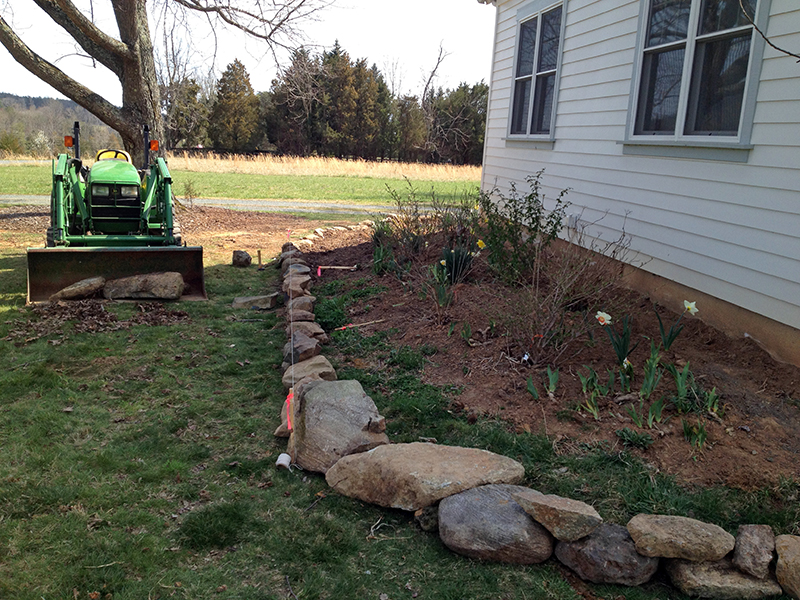November 18th, 2013 §
Today dawned in marked contrast to the last few days. In place of cool mist and fog were bright sun and almost 70 degree temperatures. I seized the opportunity to complete the year’s final tasks in the garden that surrounds the house.
I started by robbing my compost pile that’s been in the making for almost a year. It’s a mix of garden waste, grass clippings, soiled chicken house bedding, and kitchen scraps. Instead of engaging in a hot composting process, which requires a more precise mix of nitrogen-rich greens and carbonous browns, plus proper moisture and aeration, I just throw everything in a pile in the woods and let time work its magic. Which it does, yielding a worm-full and deeply nutritious mix that every fall gets spread about the farm.
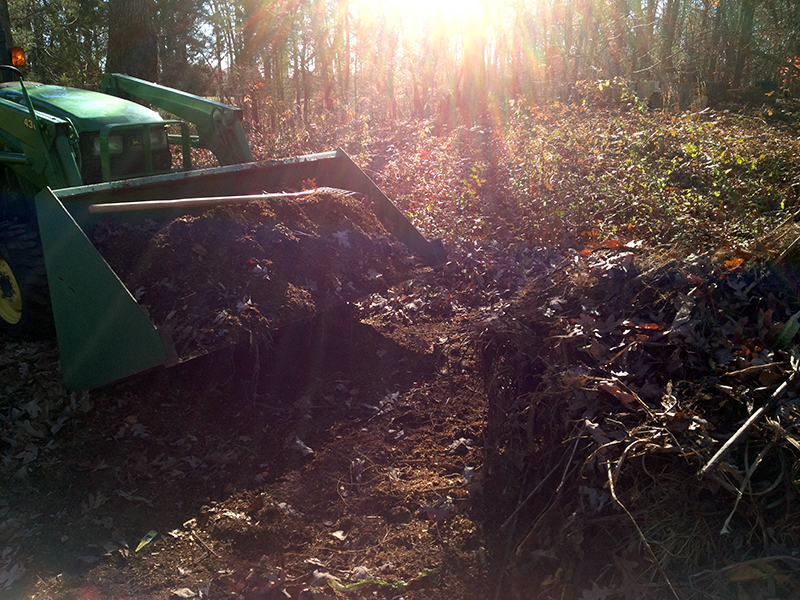
I forked the compost into the big tractor bucket. I prefer using this large bucket when dealing with bulky materials because it can carry much more than the smaller bucket. The downside, though, is that I can’t dig or scoop with this big bucket without damaging the tractor’s arms, so that means lots of hand forking. In many ways this is still necessary, though, as the margins of the pile aren’t well defined and the pile isn’t large enough to efficiently scoop with a small bucket anyway.
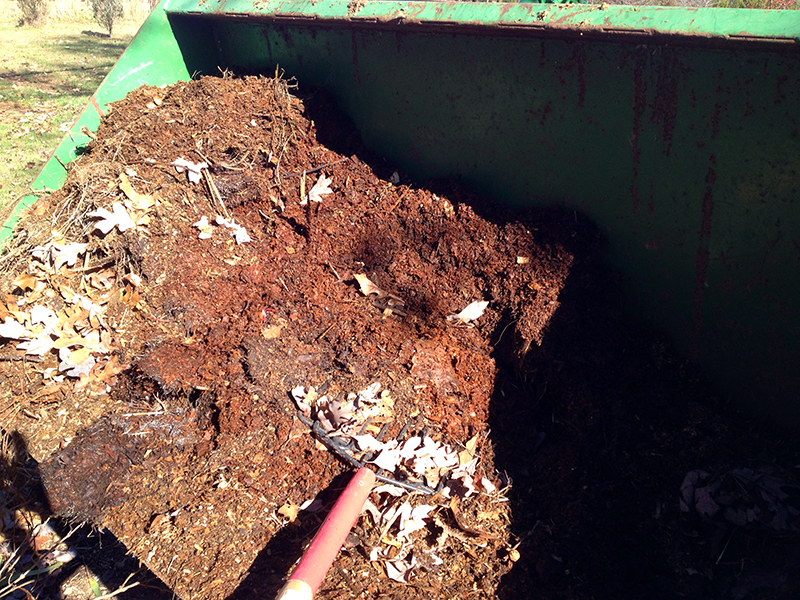
I managed to eek two large buckets of compost out of my pile. It’s not a ton, but I spread it almost an inch thick over all the exposed dirt in the garden and even had enough to pile some extra around heavy feeders, such as the roses.
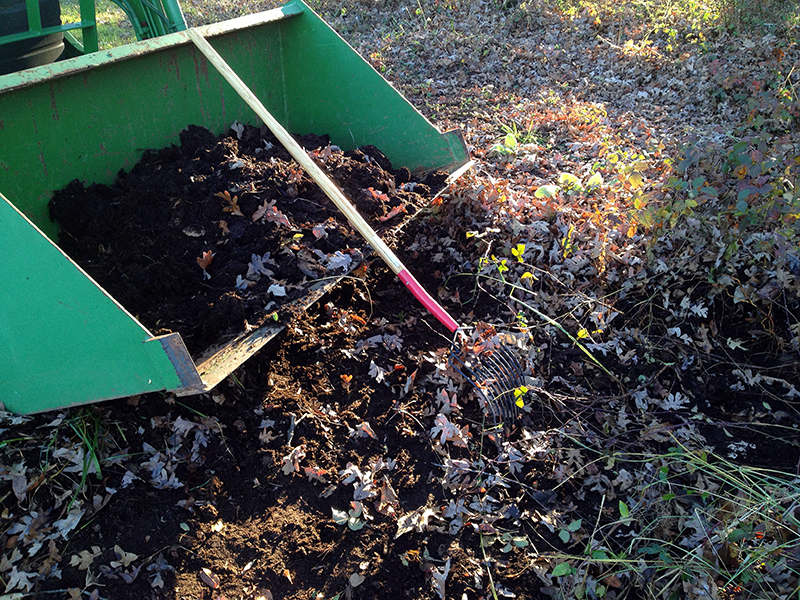
Once the compost was down, I went back for mulch. My target was the remnants of the ten yards that were delivered in early April. They’d been spread about a bit in the field and briars and grass were starting to grow up in the pile.
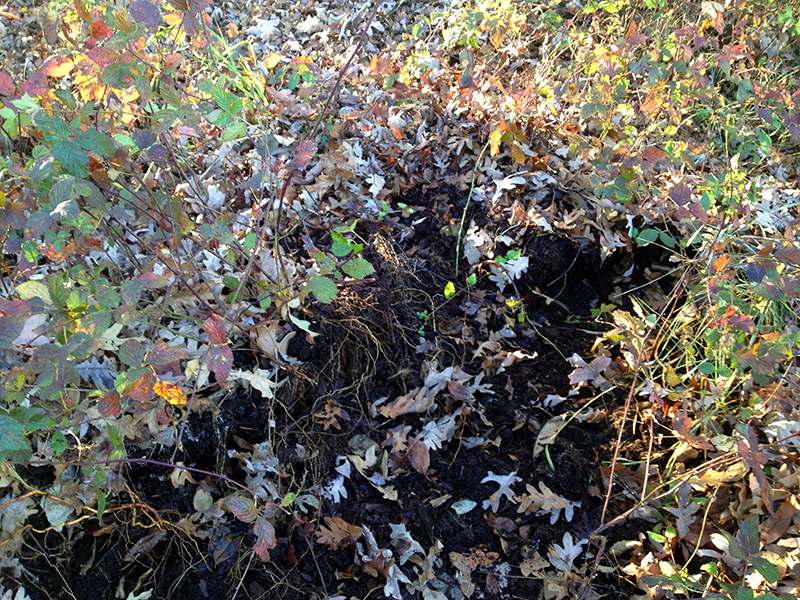
This required lots of hand forking and tedious, prickly picking through, but I managed to get four big bucketfuls out of a rather insubstantial looking pile. Not only did it feel good to reclaim something for which I’d paid good money, but the eight-month rest in the field had decomposed the mulch the absolutely perfect consistency—damp, dark, crumbly and ready to go to work building soil. It makes me realize I should be ordering all my mulch at least half a year in advance of when I want to apply it.
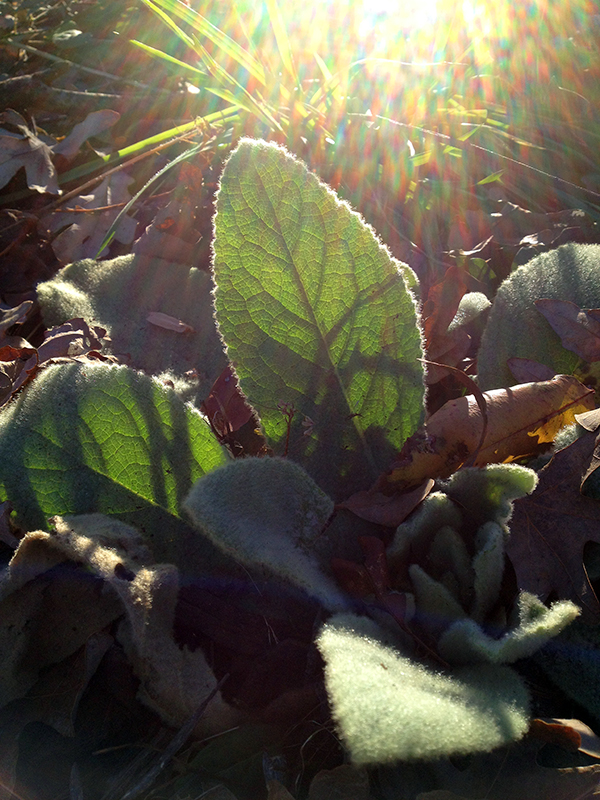
Anyone who’s been reading this blog for a while knows that when it comes to mulch, I prioritize its soil-building properties over any aesthetic contribution it may make to the landscape. The key to building good soil is keeping it mulched with an appropriate material, one that breaks down and adds organic matter to the soil. When you’re working with what I’ve got here—compacted red Virginia clay around a construction site—short of digging out all the native dirt and replacing it the only way to create great soil is through repeated application of amendments such as compost and mulch. Do that for ten or fifteen years and you might get somewhere. I am three years in and my fantasies of dropping a trowel and having it sink blade deep in rich, black soil are a long way off.
But I work at it. And will keep working at it every year as long as I can wield the pitchfork.
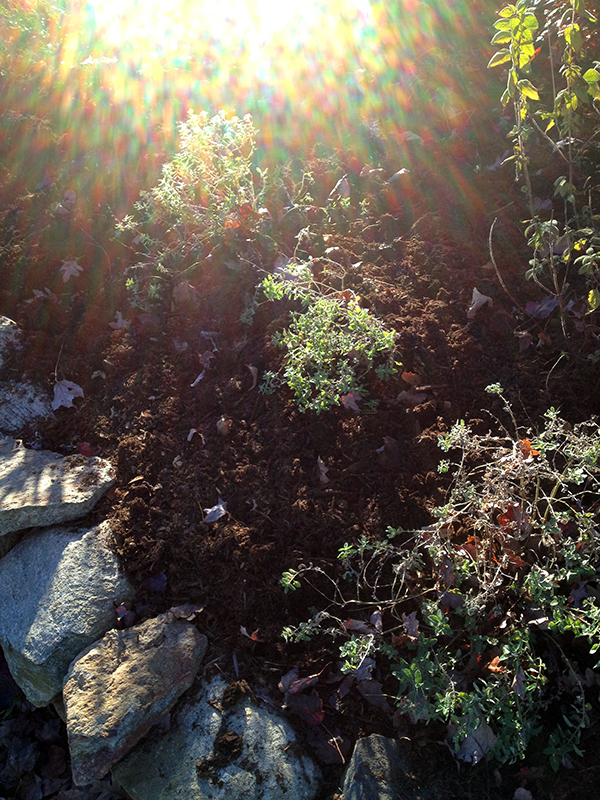
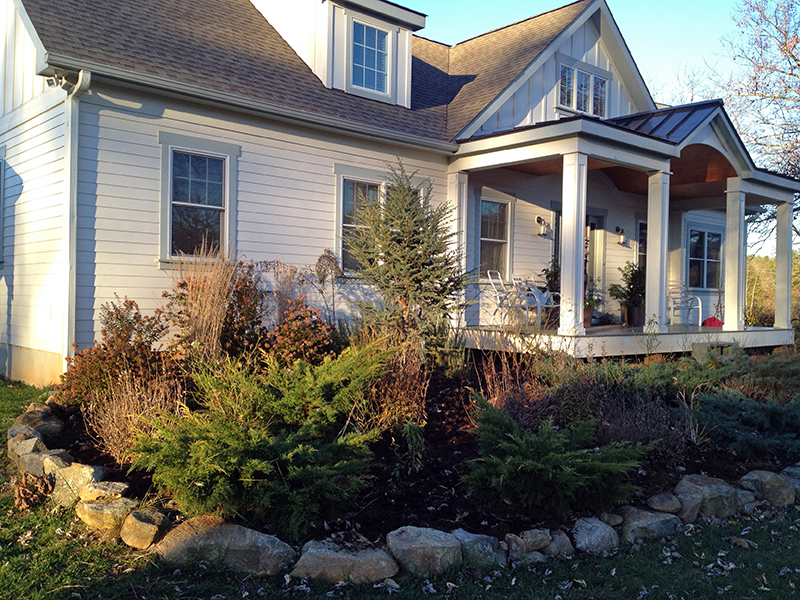
By sundown I could barely move but I was finished spreading compost and mulch, and I felt good about this final gardening act of the year. This is always one of the most physically demanding days of the year, and I am glad to have it behind me. Now I celebrate, and rest easy knowing I have left a nutritious blanket over my garden that will nourish it through this winter and into the spring to come. It’s a good feeling, despite the protest of every nerve and muscle in my bone-tired body. I’m headed for the epsom salts and a scalding bath, and most likely a well-deserved beer.
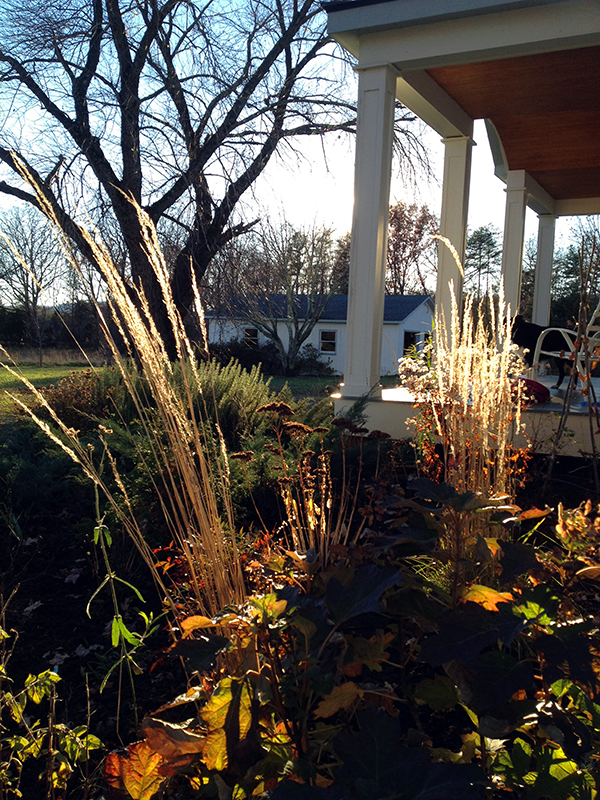
May 30th, 2013 §
Ever since I moved to Bonafide Farm, I’ve wanted to grow hops. But the infrastructure always stopped me. Hops are vines (actually, botanically they are bines) that will grow 20′ or more, and need trellises that I just didn’t have the energy to conceive and build.
But in mid-April I was down in Nelson County, which is now regionally acclaimed for its breweries (Devil’s Backbone, Blue Mountain, etc.) enjoying a post-hike flight at Wild Wolf with some friends. A sign at a shop across the patio advertised hop rhizomes. I couldn’t resist. Turns out I had discovered HomebrewZ!, a delightful little shop stocking all your homebrew essentials.
A very lovely woman sold me her last seven Cascade rhizomes and instructed me to “go across the way” to speak with another woman who would impart all the secrets of hops culture to this neophyte. I got the skinny from this sage and rejoined my friends and our dogs on the patio.
The rhizomes,which are nothing more than 3-4″ twigs, languished in a paper bag until I could do a little research and make a trip to the hardware store for supplies. Then my friend Simon and I spent an evening hauling forest topsoil and compost to the site of an old berry patch by the south side of the garage. Once we had the soil nice and juicy (hops are heavy feeders with an extensive root system), I mounted the ladder, drill in hand.
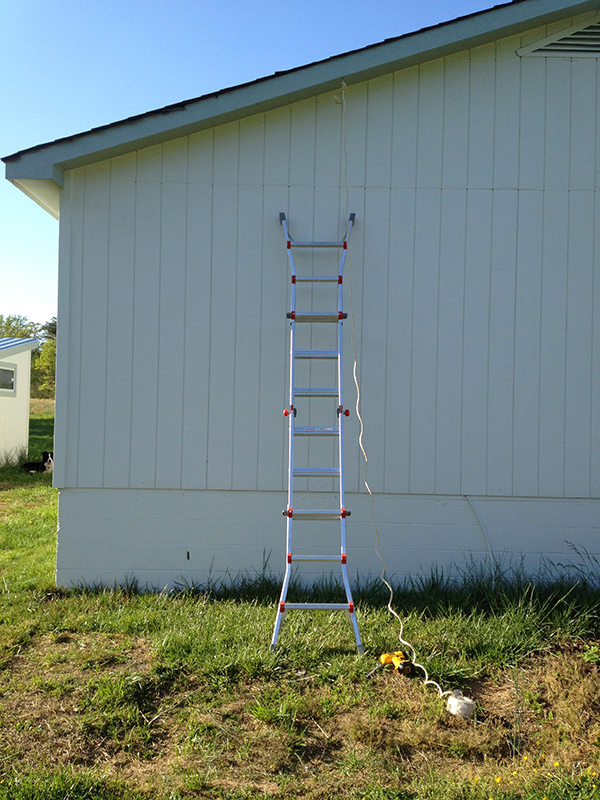
Right up under the eaves I installed two stainless steel eye-bolts. Then I ran 3/8″ sisal rope from them down to dog tie-outs that I’d screwed in to the growing bed. And this was the extent of my trellis system. One of the best things I have learned from living here is that sometimes things work out best when I am just pushed to react to what a situation demands, instead of obsessively planning to the point of inaction.
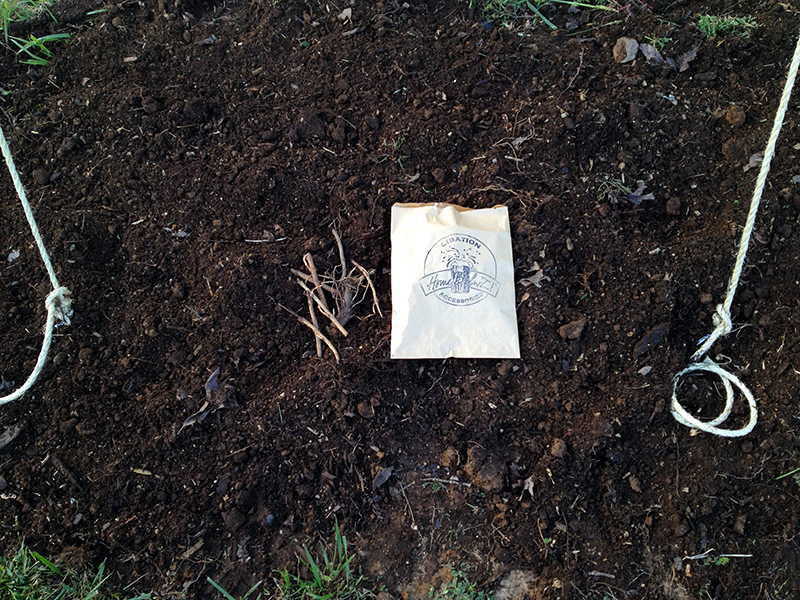
I arranged the rhizomes in the soil around each tie-out, covered them over, and hoped for the best.
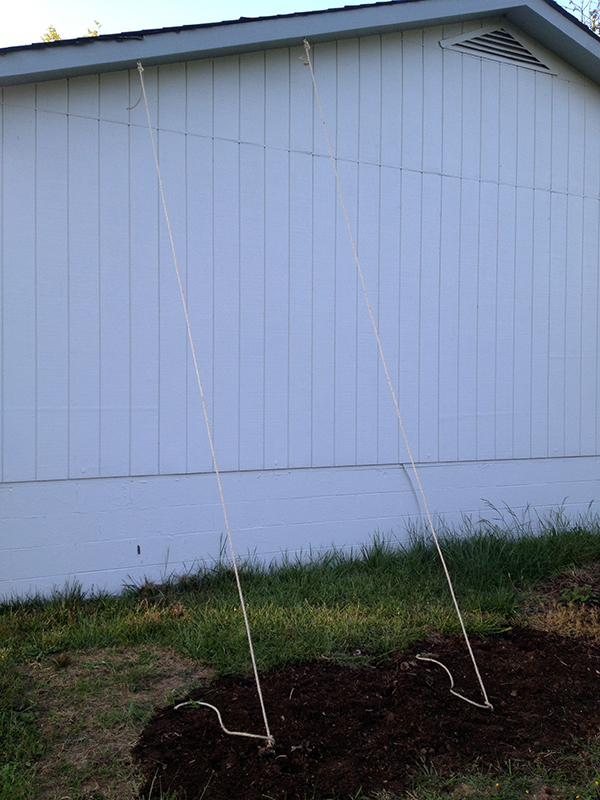
A few weeks passed with no change. Just as I began to worry that I’d gotten some dead rhizomes, tiny leaves appeared. And then there were more. I made chicken wire cages to keep the chickens from eating the hops, and in a few days more sprouts appeared. And then I went away to the beach for eight days, and when I returned my little hop babies had found their ropes and started to twine. So precocious!
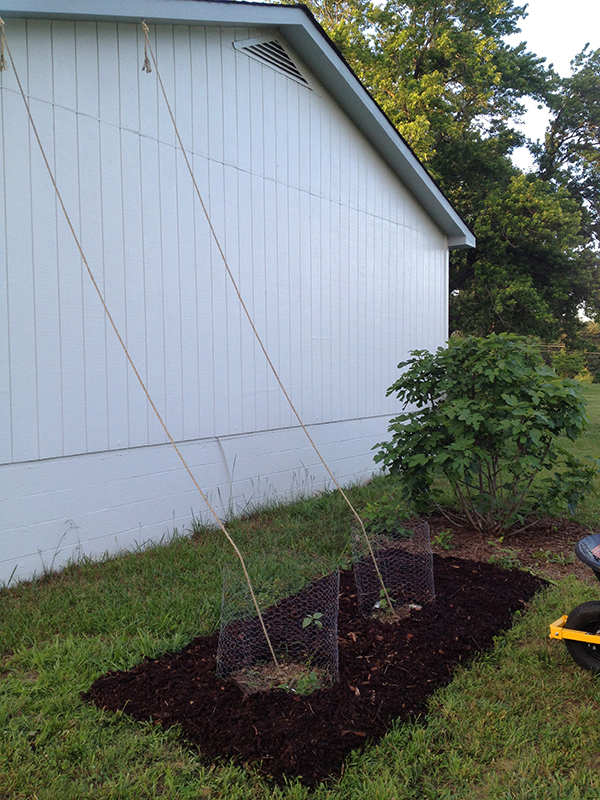
Unfortunately the pasture was fast overtaking this nice, rich new bed, so last weekend I dug out all the weeds, laid down newspaper, and piled mulch on top. This will keep the weed pressure off my hops so they can grow to their max. That’s my Celeste fig next to them, which came through this winter without any intervention from me and is on its way to becoming a beautiful asset.
I found another little snake in the mulch. This is the second “mulch snake” I’ve encountered.
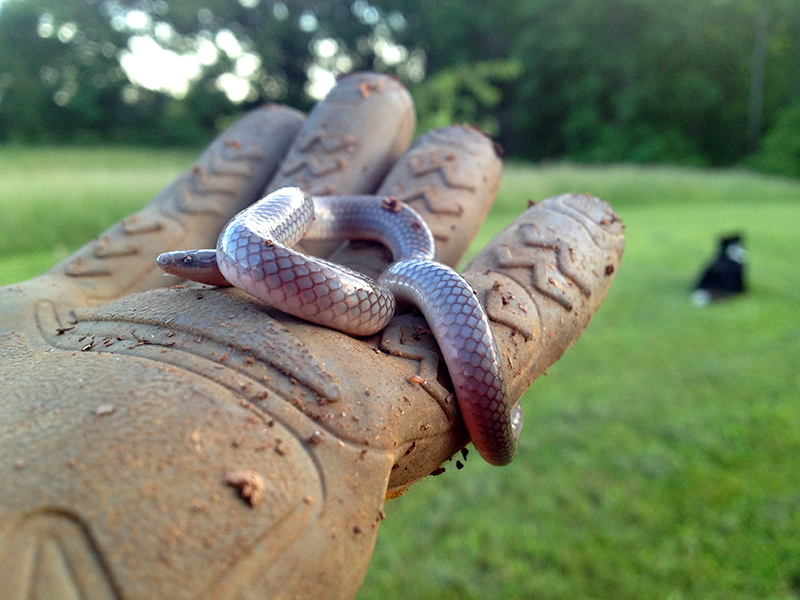
I placed him next to the growing hops. I figured twiney things belonged together.
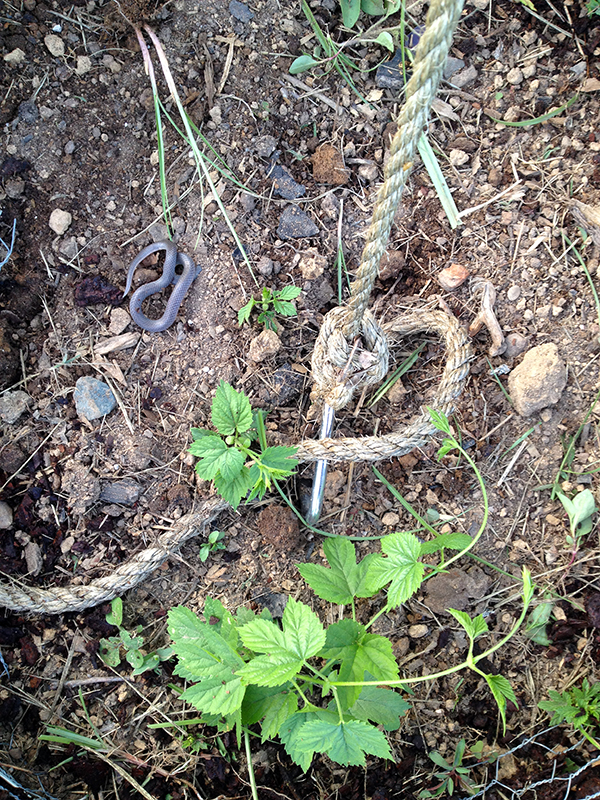
I am very excited to see what my hops do. Maybe someday I’ll be making a Bonafide Brew with my own homegrown hops! And if not, hops are a wonderful herbal sedative often used to induce sleep. A girl can dream…
May 8th, 2013 §
Once all the rocks were in place, I covered the turf that extended into the bed with newspaper several sheets thick. This grass-killing trick had been effective when I used it under the mulch rings I placed around my trees. Then I went in to the woods and dug up bucket loads of loamy topsoil, mostly with a shovel so I could pick out the rocks, sticks and vines as I went.
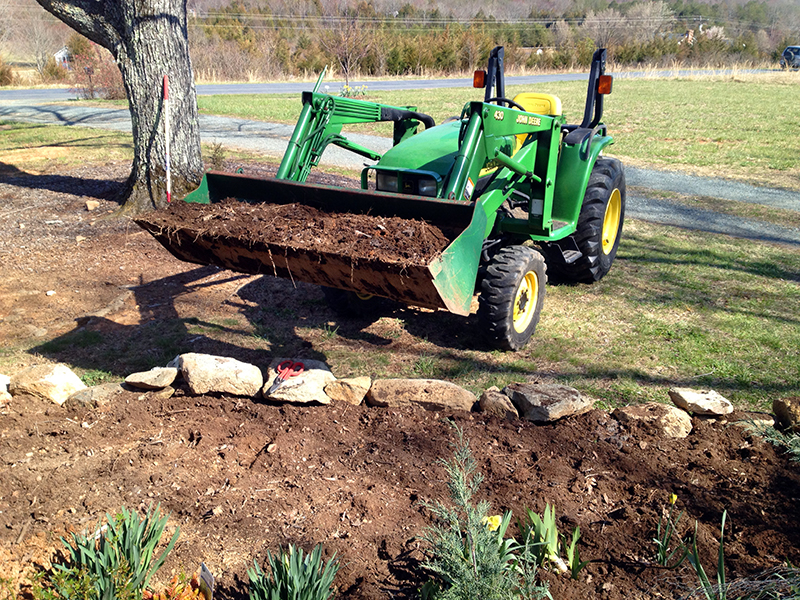
I dumped this topsoil into the new bed space, on top of the newspaper and up against the back wall of rocks, in effect forming a raised bed around two sides of the house.
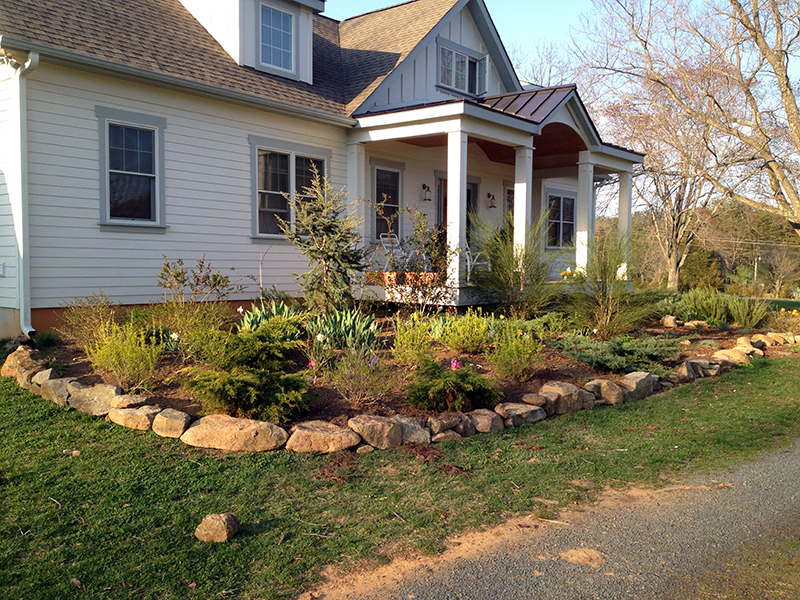
Then on April 10 I called my favorite mulch guy and had ten yards of double shredded hardwood mulch dropped near the woods. This is prettier—and more expensive—than the pine bark nuggets I buy for mulching around my big trees (below, on the ground). It will also break down much faster, helping to enrich the soil as it does.

I spent a day hand-forking the aforementioned ten yards of mulch into my garden. It was super-tricky, delicate work as many of my perennials were just starting to emerge and hard to see, and I didn’t want to smother them.
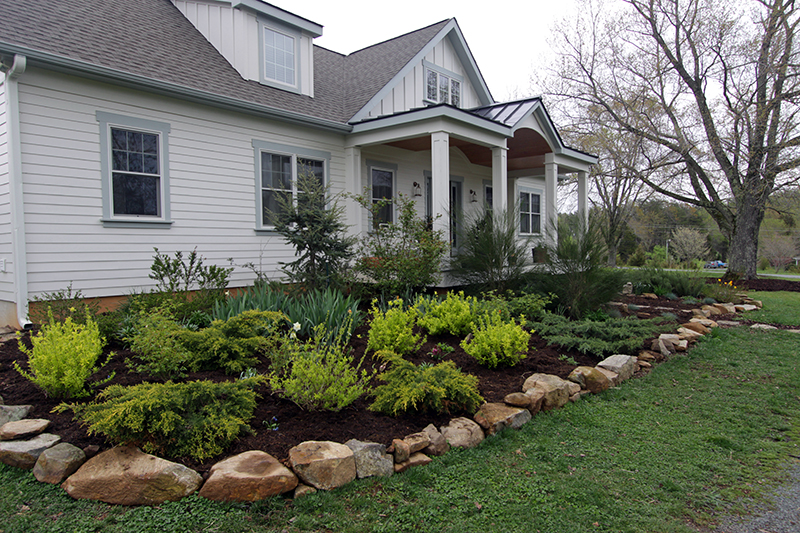
But after eight hours of mulching and only a few blisters across my palms, it was done. And looked pretty nice, I thought. There are a few spots that can use another stone or two, but I will fill those in once I’ve fully recovered.
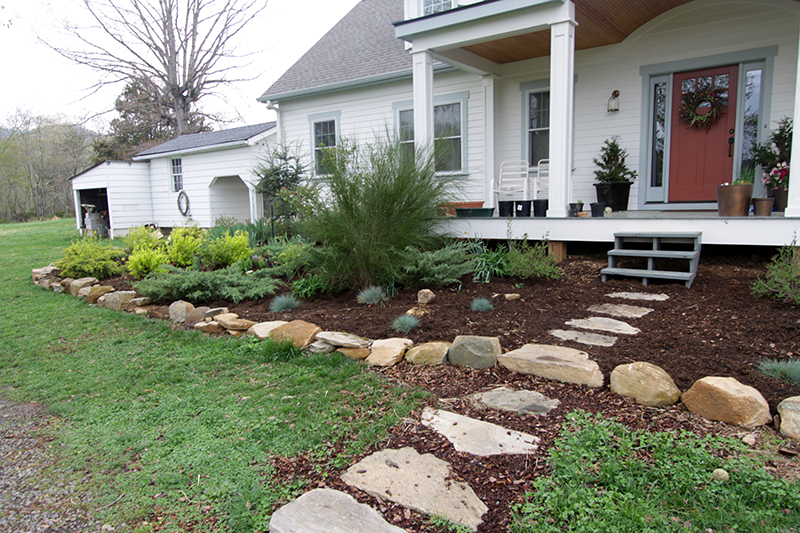
It’s not the fancy hardscape I’d most love, but for $285 worth of mulch and untold hours of bodybreaking labor, I finally have some decent-looking garden beds that are in keeping with the informal, cottage nature of the house. What’s more, this project massively contributes toward my goal of making maintenance around here as easy as possible. Now I just run the string trimmer right up against the rocks—which means no more futile hours spent hacking enroaching turf out of the beds. Plus, the mulch will help keep weeds out and moisture in during the hot summer while feeding the soil and coddling the earthworms beneath.
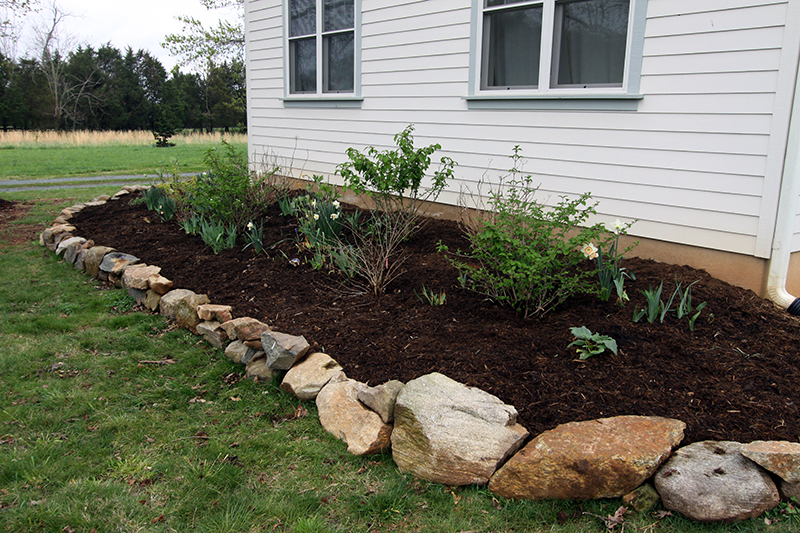
And, I am really excited to have gained a bit more extra bed space, complete with pretty decent soil—thanks, forest! I have already started planting some fun new additions, including peonies for the shadier areas and sedums for the sunny front corner. My plan is to eventually colonize the rock wall with sedums growing over it and through the spaces between rocks.
The garden has really come on in the weeks since these pictures were taken, so a little virtual plant walk will be coming soon.
May 7th, 2013 §
Much of March and April was devoted to building a rock wall around the front and road-facing side of the house. I’d grown tired of hacking turf out of the unedged beds, and the bed on the side of the house that faces the road was too steep to hold water on the plants in it. As you can see below, within the stone wall, it wasn’t a good look. Last summer I’d gotten some quotes to build a nice stone retaining wall around this end of the house and around the front, with a flagstone front walk and stairs. The quotes ranged from $8,000-$18,000, which just wasn’t in the budget at this time in my life.
So I started pulling rocks out of piles in the woods and used the tractor to get them near the house. Some of these rocks were the foundation of the house I tore down to build mine, and others no doubt came from clearing the pastures way back when. All winter long I played around with the rocks, moving them many times until I got them arranged in a line I liked and that would almost double the depth of the bed on this front corner of the house.
I had really low expectations for this project, as I think rock-edged beds can be pretty stupid looking. And I know that a proper rock wall is dug into the ground for stability and protection against frost heave. But I made peace with the idea that this didn’t have to be a perfectly permanent solution, and I figured that if I used rocks that were as large as I could handle the installation would appear more like a rock wall and less like a line of rocks, which is exactly what it looked like below, during the head-scratching phase of this project.
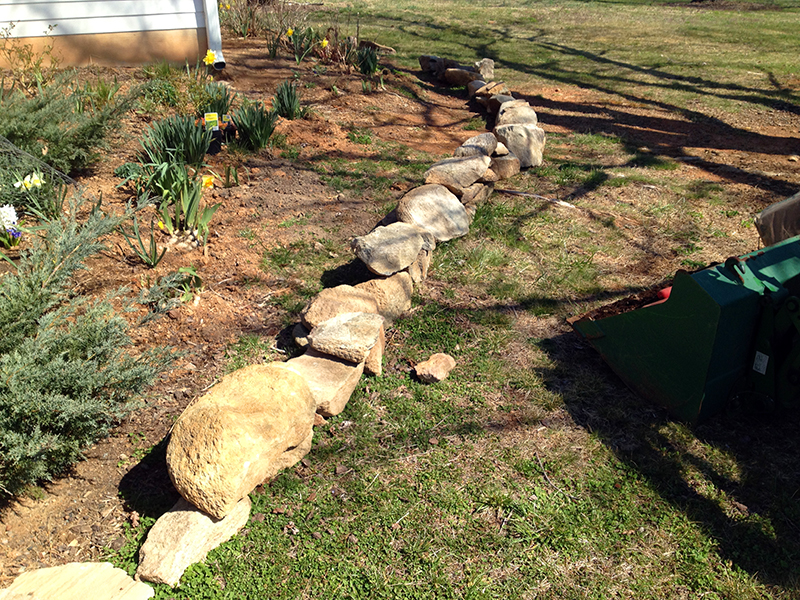
I’d been having trouble with runoff from the downspout in the above photo. Every time it rained, water ran down the bed and pooled near a maple tree in the yard, messing up its mulch ring and eroding the bank. So I figured that I’d take care of this issue by burying a drainage pipe under the bed I was expanding. It was easy to dig it in and hide its opening at the inside edge of the new wall. The bottom of the pipe is dotted with quarter-sized holes that let water escape as it flows away from the downspout.
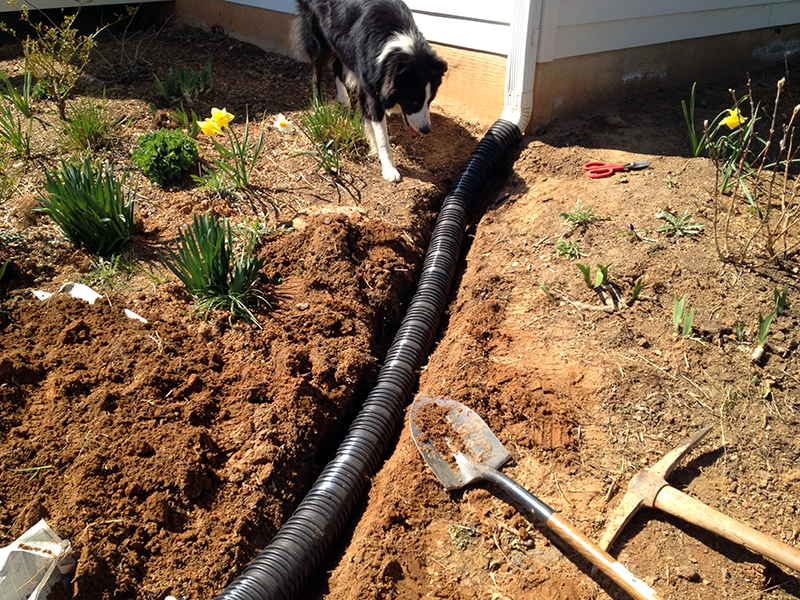
Then I went back to the woods for more rocks, some of which took every ounce of my strength and willpower to budge into the tractor bucket. I don’t remember how many trips it took, but there are 173 rocks in this installation and many are not insignificantly sized.
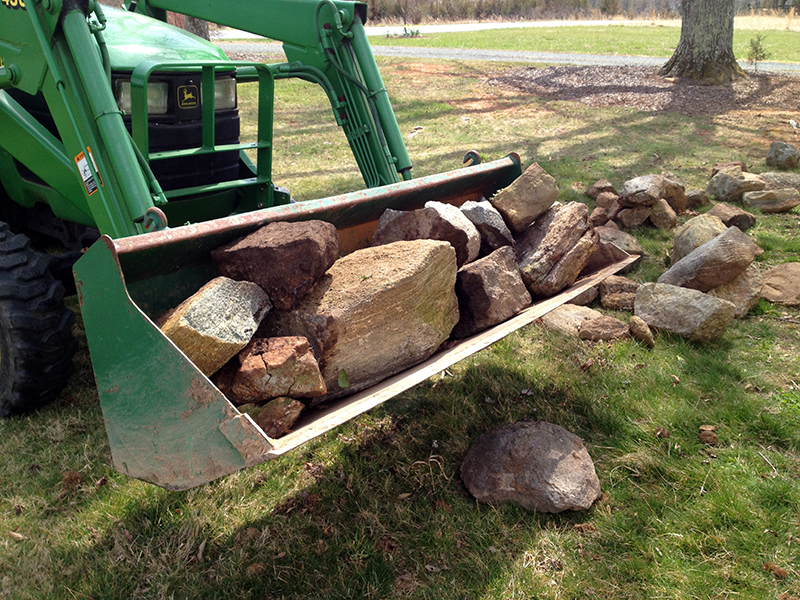
I spent days fiddling with rocks, turning each this way and that, trying my best to fit them into a wall-like configuration. Of course this week coincided with our freak 90-degree April heat wave. Let’s just say I got tan and back to my summer weight during this heavy-labor boot camp!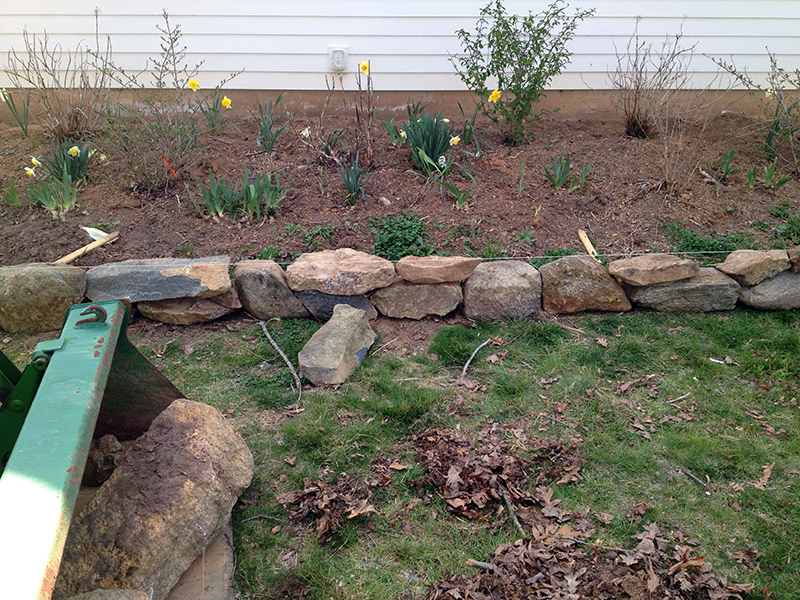
Up next, the wall continues…
